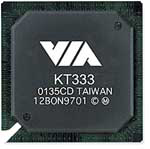With the
exact same hardware and the Epox 8KHA+
or
the Abit KR7A running at 170 MHz FSB (for example), the boards
based on the older KT266A often outperformed KT333CE based board running at the blistering speed
of 200 MHz+ FSB!
For the Epox 8K3A+ (KT333CE) to match the Epox 8KHA+ (KT266A)
in 3DMark the Epox 8K3A+ had to be run around 30 MHz higher in FSB! If the problems were
exclusive to 3DMark it wouldn't be that big a deal, however Quake III Arena
(which is known to crave memory bandwidth/high FSB's) also exhibited up to a 20 fps
difference in tests.
One thing we been
observing over the past few months is that the memory bandwidth scores
other hardware review websites were reporting were not that impressive for the
KT333CE chipset. Most sites had been using KT333CE-based motherboards for their
reference platforms as they were able to hit speeds in excess of 200 MHz FSB
with aggressive memory timings. At the same time they seemed to be falling short
of KT266A motherboads (such as the Abit KR7A) teamed up with some
PC3000 DDR at
200 MHz FSB
with the
most relaxed memory timings!
Our own testing seems to
indicated that the memory controller on the VIA KT333CE maybe tweaked more for
compatibility and high FSB's more then overall performance since we
were unable to get the KT333CE-base boards to match the KT266A based
motherboards in terms of memory bandwidth.
The tests are coming:
To illustrate what we mean, we have set up a an all out
brawl between our VIA KT266A and VIA KT333CE based motherboards. The boards
were tested at stock speeds and at 166 MHz to see which
chipset really
is
faster. Our combatants representing the KT333CE side will be the Epox 8K3A+ and
the Shuttle AK35GTR Ver 2.2. The
Epox 8KHA+ and Abit KR7A-133RAID
will fight for the KT266A chipset side.
Our results were very interesting to say the least! We did
have another KT333CE board, however the Soltek
SL-75DRV5 KT333CE didn't overclock
well and our MSI
KT3 Ultra-ARU is based on the earlier beta
KT333CD
chipset.
